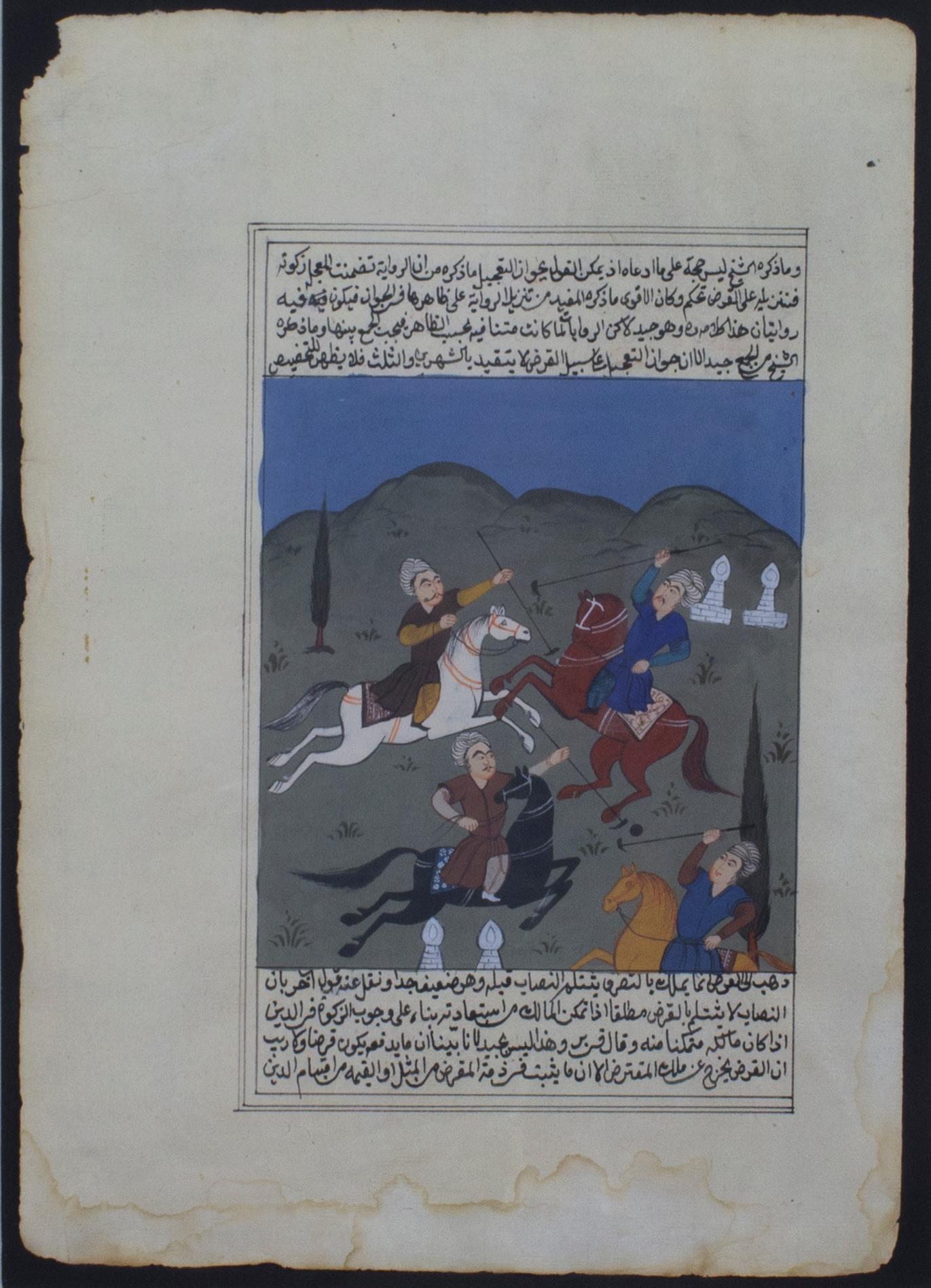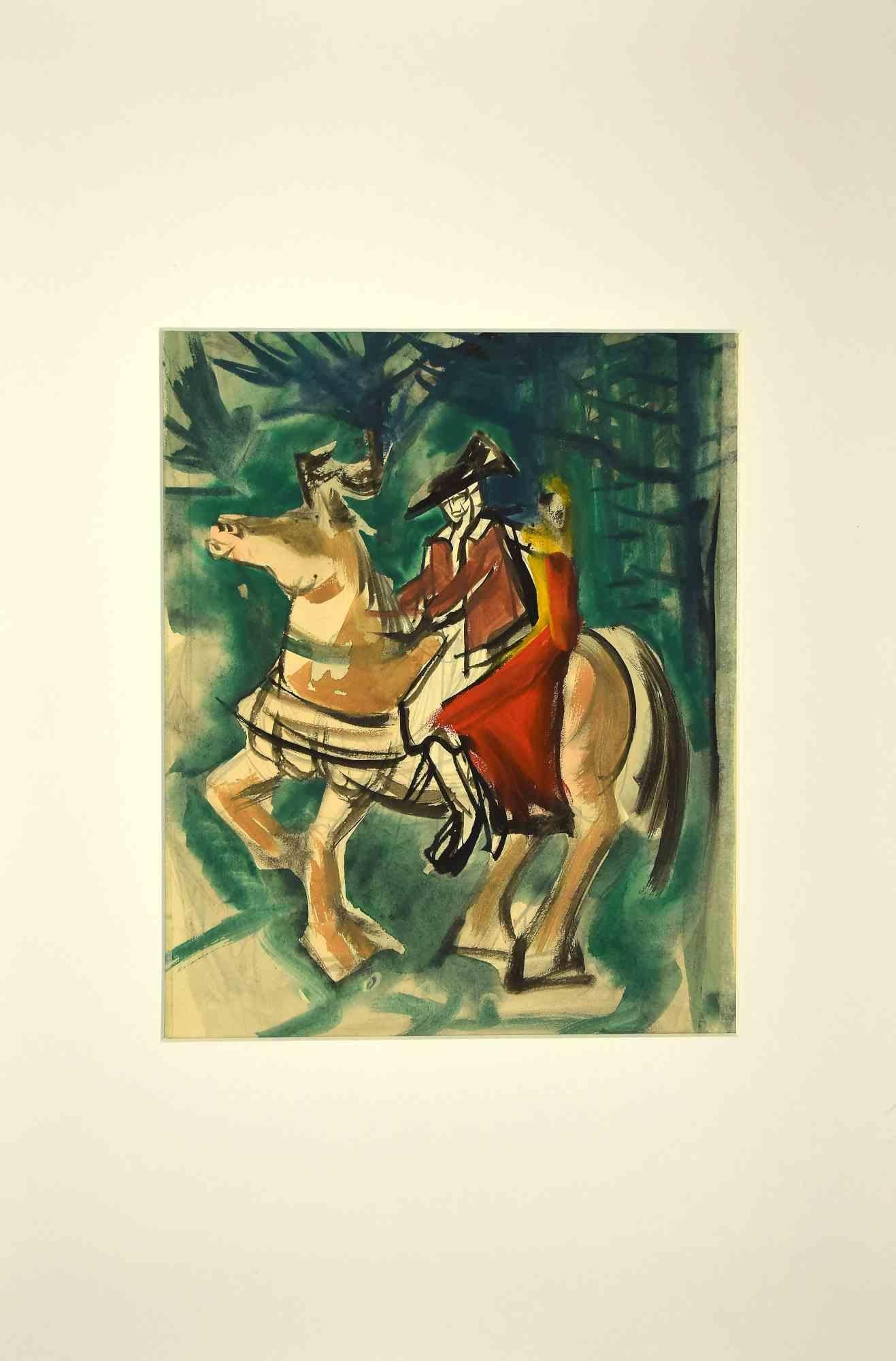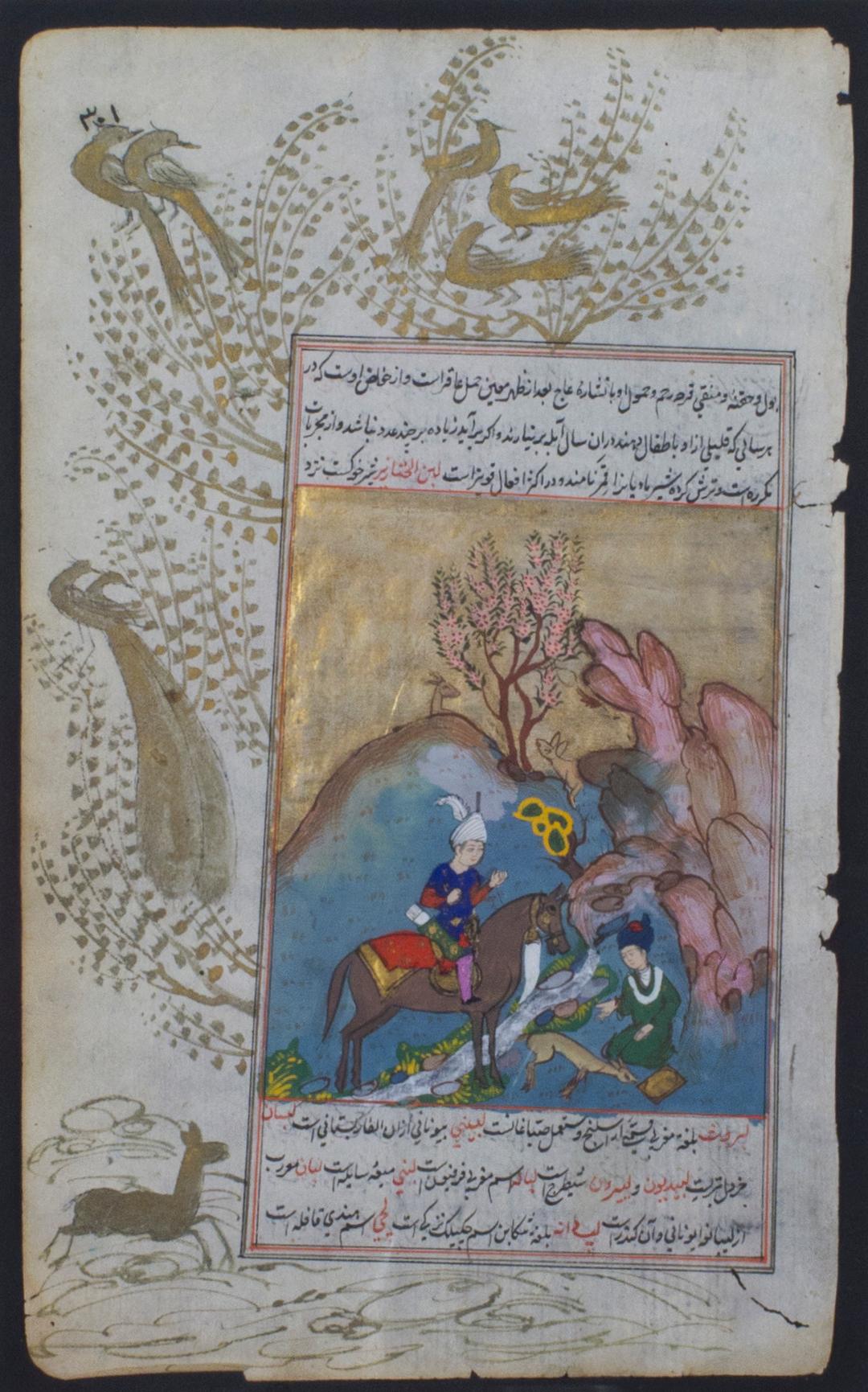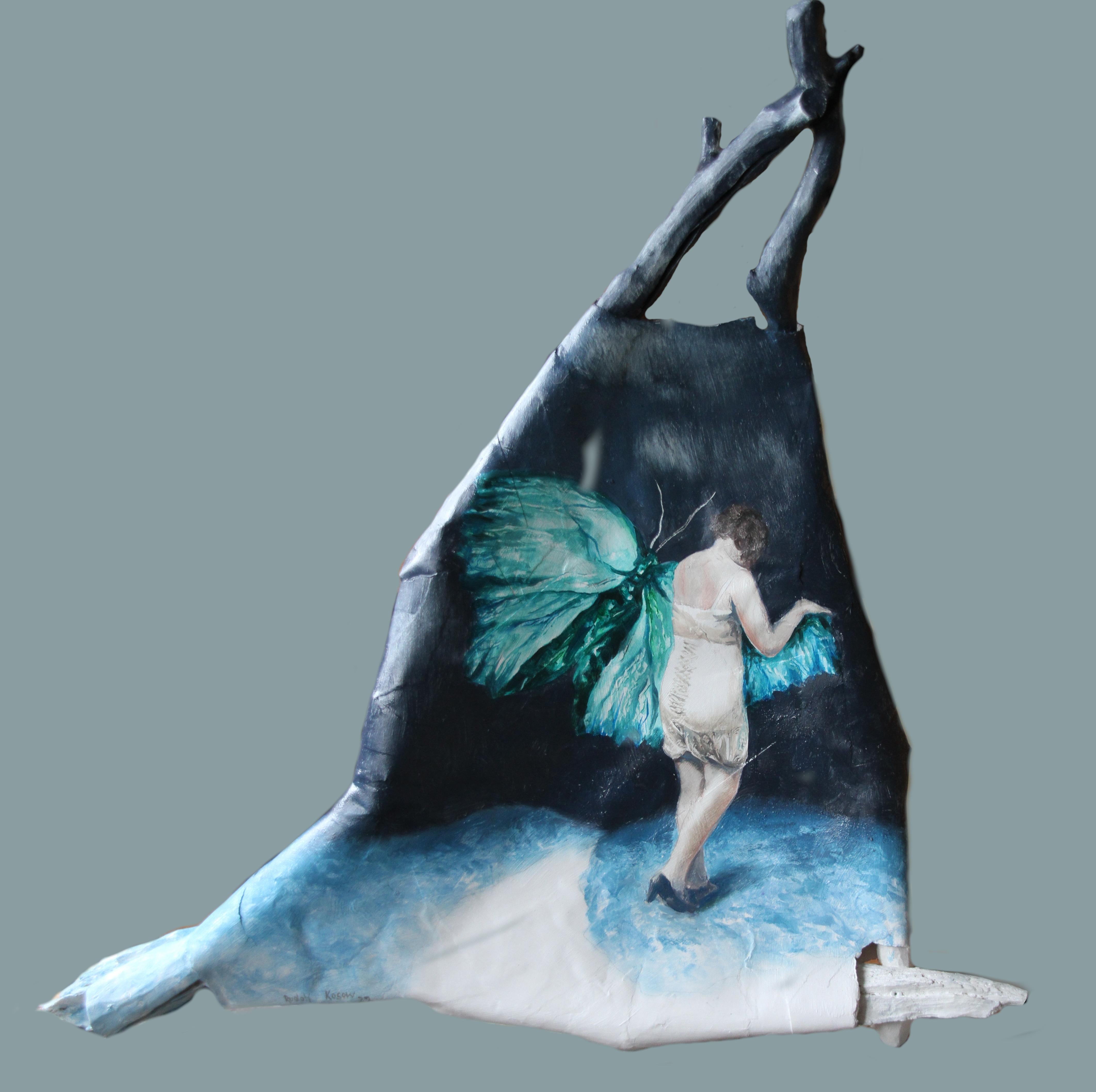Items Similar to Persian Illuminated Miniature with Three Hunters on Horseback in a Landscape
Want more images or videos?
Request additional images or videos from the seller
1 of 9
UnknownPersian Illuminated Miniature with Three Hunters on Horseback in a LandscapeLate 19th c.
Late 19th c.
About the Item
The present illuminated folio page contains a fine miniature depicting three figures hunting while on horseback, an image meant to accompany a historic epic. During the medieval period, hunting was an important pastime of male nobility throughout the Islamic world. The Quran itself explicitly endorses hunting and the use of animals to aid in capturing prey: "Lawful to you are foodstuffs that are good to eat and any game that, at your wish, is captured by beasts of prey which train as you do dogs, according to the method that Allah has taught you, after you have spoken the name of Allah over it." (Q 6:4) Muslim princes and nobles enjoyed the chase of the prey via horseback, using bow and arrow, crossbows, and blowpipes to capture their prey Horseback riding itself trained young men in the necessary skills for armed combat and warfare, developing their speed and strength.
12 x 8.25 inches, artwork
19.75 x 15.88 inches, frame
accompanied on the back with an image of the verso
framed to conservation standards with a 100% rag silk-lined mat in a gold gilded frame
A Persian miniature is a small Persian painting on paper, whether a book illustration or a separate work of art intended to be kept in an album of such works called a muraqqa. The techniques are broadly comparable to the Western and Byzantine traditions of miniatures in illuminated manuscripts. Although there is an equally well-established Persian tradition of wall-painting, the survival rate and state of preservation of miniatures is better, and miniatures are much the best-known form of Persian painting in the West, and many of the most important examples are in Western, or Turkish, museums. Miniature painting became a significant genre in Persian art in the 13th century, receiving Chinese influence after the Mongol conquests, and the highest point in the tradition was reached in the 15th and 16th centuries. The tradition continued, under some Western influence, after this, and has many modern exponents. The Persian miniature was the dominant influence on other Islamic miniature traditions, principally the Ottoman miniature in Turkey, and the Mughal miniature in the Indian sub-continent.
Persian art under Islam had never completely forbidden the human figure, and in the miniature tradition the depiction of figures, often in large numbers, is central. This was partly because the miniature is a private form, kept in a book or album and only shown to those the owner chooses. It was therefore possible to be more free than in wall paintings or other works seen by a wider audience. The Qur'an and other purely religious works are not known to have been illustrated in this way, though histories and other works of literature may include religiously related scenes, including those depicting the Prophet Muhammed, after 1500 usually without showing his face.
As well as the figurative scenes in miniatures, which this article concentrates on, there was a parallel style of non-figurative ornamental decoration which was found in borders and panels in miniature pages, and spaces at the start or end of a work or section, and often in whole pages acting as frontispieces. In Islamic art this is referred to as "illumination", and manuscripts of the Qur'an and other religious books often included considerable number of illuminated pages. The designs reflected contemporary work in other media, in later periods being especially close to book-covers and Persian carpets, and it is thought that many carpet designs were created by court artists and sent to the workshops in the provinces.
In later periods miniatures were increasingly created as single works to be included in albums called muraqqa, rather than illustrated books. This allowed non-royal collectors to afford a representative sample of works from different styles and periods. [Wikipedia]
- Creation Year:Late 19th c.
- Dimensions:Height: 19.75 in (50.17 cm)Width: 15.88 in (40.34 cm)
- Medium:
- Period:
- Condition:Some water damage along the bottom. See images.
- Gallery Location:Milwaukee, WI
- Reference Number:
About the Seller
4.9
Platinum Seller
These expertly vetted sellers are 1stDibs' most experienced sellers and are rated highest by our customers.
Established in 1966
1stDibs seller since 2017
391 sales on 1stDibs
Typical response time: 1 hour
- ShippingRetrieving quote...Ships From: Milwaukee, WI
- Return PolicyThis item cannot be returned.
More From This SellerView All
- Persian Illuminated Miniature with Four Figures Playing Polo in a LandscapeLocated in Milwaukee, WIThe present illuminated folio page contains a fine miniature depicting four figures playing polo. Polo, also called 'chagun,' was the sport of kings and princes of central Asia and Iran, and the sport probably originated there in the 6th century BCE. Polo matches appear in a large number of early Persian texts, including in the writings of the 10th century epic writer Abu l-Qasim al-Firdawsi: He describes numerous polo matches in his famous 'Shahnameh' (The Persian Book of Kings). This particular illumination also is closely related to an example held at the Smithsonian Museum of Asian Art: a folio from 'Guy u Chawgan' (The ball and the polo-mallet) which shows a polo game with the dervish and the shah. 12 x 8.25 inches, artwork 19.75 x 15.88 inches, frame accompanied on the back with an image of the verso framed to conservation standards with a 100% rag silk-lined mat in a gold gilded frame A Persian miniature is a small Persian painting on paper, whether a book illustration or a separate work of art intended to be kept in an album of such works called a muraqqa. The techniques are broadly comparable to the Western and Byzantine traditions of miniatures in illuminated manuscripts. Although there is an equally well-established Persian tradition of wall-painting, the survival rate and state of preservation of miniatures is better, and miniatures are much the best-known form of Persian painting in the West, and many of the most important examples are in Western, or Turkish, museums. Miniature painting became a significant genre in Persian art in the 13th century, receiving Chinese influence after the Mongol conquests, and the highest point in the tradition was reached in the 15th and 16th centuries. The tradition continued, under some Western influence, after this, and has many modern exponents. The Persian miniature was the dominant influence on other Islamic miniature traditions, principally the Ottoman miniature...Category
19th Century Other Art Style Figurative Paintings
MaterialsInk, Tempera, Laid Paper
- Persian Illuminated Miniature with Two Figures Hunting in a LandscapeLocated in Milwaukee, WIThe present illuminated page was once part of a larger manuscript, as evidenced by the tears along the right edge, illustrating a story from the Islamic world. The scene presents two figures in a landscape, one on horseback and another gesturing to a fallen deer. The stylization of the landscape shows influence from the Byzantine tradition of painting, with jagged rocks jutting into a golden sky. The page contains handwritten text on both sides, and is surrounded by gold illustrations of peacocks and a running deer. 11 x 6.5 inches, artwork 18.63 x 14 inches, frame accompanied on the back with an image of the verso framed to conservation standards with a 100% rag silk-lined mat in a gold gilded frame A Persian miniature is a small Persian painting on paper, whether a book illustration or a separate work of art intended to be kept in an album of such works called a muraqqa. The techniques are broadly comparable to the Western and Byzantine traditions of miniatures in illuminated manuscripts. Although there is an equally well-established Persian tradition of wall-painting, the survival rate and state of preservation of miniatures is better, and miniatures are much the best-known form of Persian painting in the West, and many of the most important examples are in Western, or Turkish, museums. Miniature painting became a significant genre in Persian art in the 13th century, receiving Chinese influence after the Mongol conquests, and the highest point in the tradition was reached in the 15th and 16th centuries. The tradition continued, under some Western influence, after this, and has many modern exponents. The Persian miniature was the dominant influence on other Islamic miniature traditions, principally the Ottoman miniature...Category
19th Century Other Art Style Figurative Paintings
MaterialsGold Leaf
- "Rice Harvest, " Tempera on Canvas signed by Indonesian artist KelishiLocated in Milwaukee, WI"Rice Harvest" is an original tempera painting on canvas by an Indonesian artist. The signature may be "Kelishi" "M.D." or something similar and can ...Category
Early 20th Century Folk Art Figurative Paintings
MaterialsTempera, Canvas
- "Indian Pow-Wow, " Original Tempera Painting signed by David BarnettBy David BarnettLocated in Milwaukee, WI"Indian Pow-Wow" is an original painting in tempera, signed in the lower right. It features gestural blue outlines, decorated in shades of yellow, blue, and green. Art size: 24" x 1...Category
1960s Contemporary Figurative Paintings
MaterialsTempera
- Kees Van Dongen Circus Performers 1900s Vintage Vibrant Figure Fauvist SignedBy Kees van DongenLocated in Milwaukee, WI"Les Artistes du Cirque" is an original painting in ink, watercolor, and gouache on paper by leading Fauvist artist Kees Van Dongen, signed in the lower right. In the piece, two circus performers stand against against a wall. On the left, a pale woman in a blue leotard with red flowers on the shoulder stands with her arms crossed, looking out at the viewer. The painter fills in her tights with delicate white brushstrokes, lending them an almost iridescent appearance. Her strawberry blond hair is piled on top of her hair according to the fashion of the period. On the right, an African man stands in a vivid orange toga, looking somewhere off to the left. His feet are clad in bright white shoes...Category
Early 1900s Fauvist Figurative Paintings
MaterialsPaper, Ink, Watercolor, Gouache
- Vielle Femme en Petite CapeBy Jacques VillonLocated in Milwaukee, WISigned with stamp, J.V. 7-5/8" x 4-3/4" art 19" x 15-1/4" frame Jacques Villon (French, 1875 - 1963) French painter, printmaker and illustrator. The oldest of three brothers who became major 20th-century artists, including Raymond Duchamp-Villon and Marcel Duchamp, he learnt engraving at the age of 16 from his maternal grandfather, Emile-Frédéric Nicolle (1830-94), a ship-broker who was also a much appreciated amateur artist. In January 1894, having completed his studies at the Lycée Corneille in Rouen, he was sent to study at the Faculty of Law of the University of Paris, but within a year he was devoting most of his time to art, already contributing lithographs to Parisian illustrated newspapers such as Assiette au beurre. At this time he chose his pseudonym: Jack (subsequently Jacques) in homage to Alphonse Daudet’s novel Jack (1876) and Villon in appreciation of the 15th-century French poet François Villon...Category
Early 1900s Impressionist Figurative Paintings
MaterialsIndia Ink, Gouache
You May Also Like
- Knight and Girl - Painting - 1950sLocated in Roma, ITKnight and Girl is an original painting realized by an anonymous artist in the 1950s. Painting in tempera, watercolor, and China ink on paper. Included a Passepartout: 41 x 51 cm. ...Category
1950s Modern Mixed Media
MaterialsInk, Tempera, Watercolor
- One more (vintage golfer yellow shirt wood painting sculpture tridimensional)By Rudolf KosowLocated in Quebec, QuebecOne More is a tridimensional original painting on paper on branches depicting a golfer playing on a field on a sunny day. keywords; golfer, yellow shirt,...Category
2010s Surrealist Mixed Media
MaterialsDriftwood, Oil, Laid Paper
- Busy (vintage ladies woman lingerie 3D oil painting paper branches surrealist)By Rudolf KosowLocated in Quebec, QuebecBusy is a tridimensional original painting on paper on branches depicting tailor ladies working taking body measurements along a path in a dark night. keywords; vintage tailor ladi...Category
2010s Surrealist Mixed Media
MaterialsDriftwood, Oil, Laid Paper
- Hermits (blue butterfly Woman vintage lingerie surrealist oil painting sculptureBy Rudolf KosowLocated in Quebec, QuebecHermits is a tridimensional original painting on paper on branches depicting a woman next to a giant butterfly along a path in a dark night. keywords; butterfly, woman, lingerie, americana...Category
2010s Surrealist Mixed Media
MaterialsOil, Driftwood, Laid Paper
- Harmony and Discord IILocated in Dubai, DUReferencing the H.G. Wells book written in 1929, ‘The Outline of History,’ which demarcates the atlas through colonization over recorded events. The work responds to the book and ide...Category
2010s Figurative Paintings
MaterialsAcrylic, Laid Paper
- Harmony and DiscordLocated in Dubai, DUReferencing the H.G. Wells book written in 1929, ‘The Outline of History,’ which demarcates the atlas through colonization over recorded events. The work responds to the book and ide...Category
2010s Conceptual Figurative Paintings
MaterialsAcrylic, Laid Paper
Recently Viewed
View AllMore Ways To Browse
In Laid
Fine Miniatures
Miniature Paper Art
Antique Painting On Silk
Persian Paintings
Persian Painting
Book Cover Antique
Art 13th Century
Ink On Silk Art
Persian Art Painting
Antique Miniature Painting
Antique Miniature Painting Paintings
Antique Miniature Paintings Paintings
Antique Miniature Paintings
Miniature Figures
Human Figures Of Three
Medieval Period
Horseback Painting



